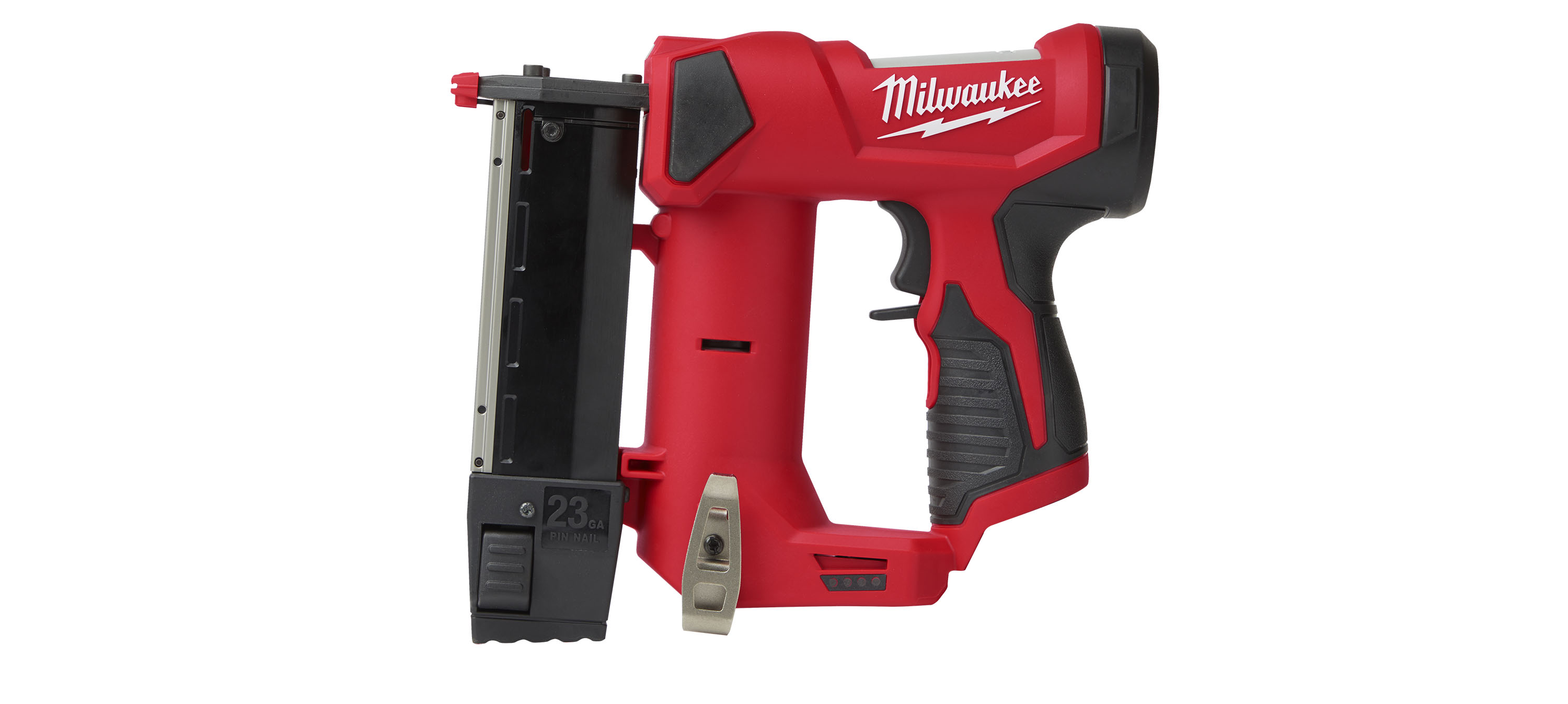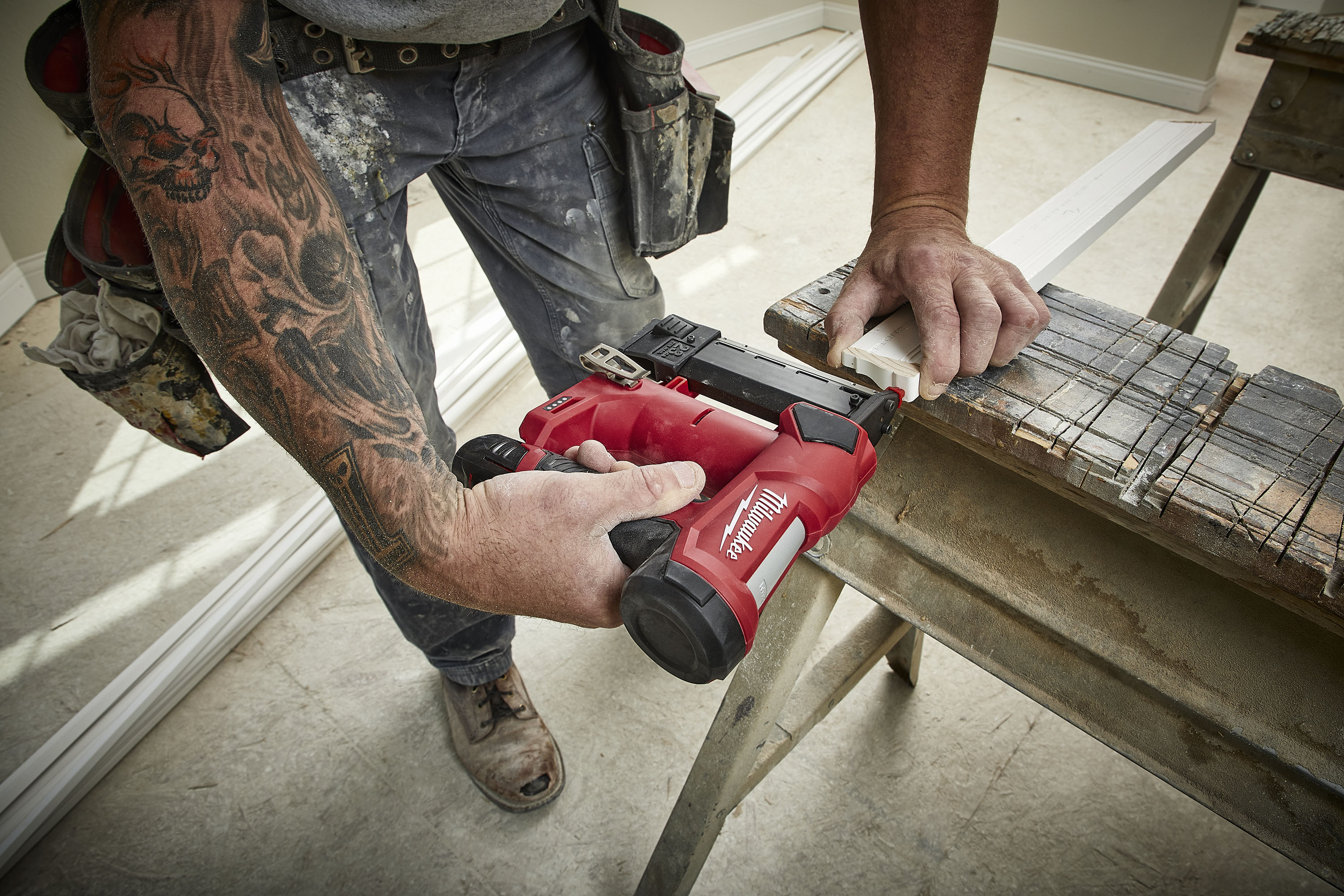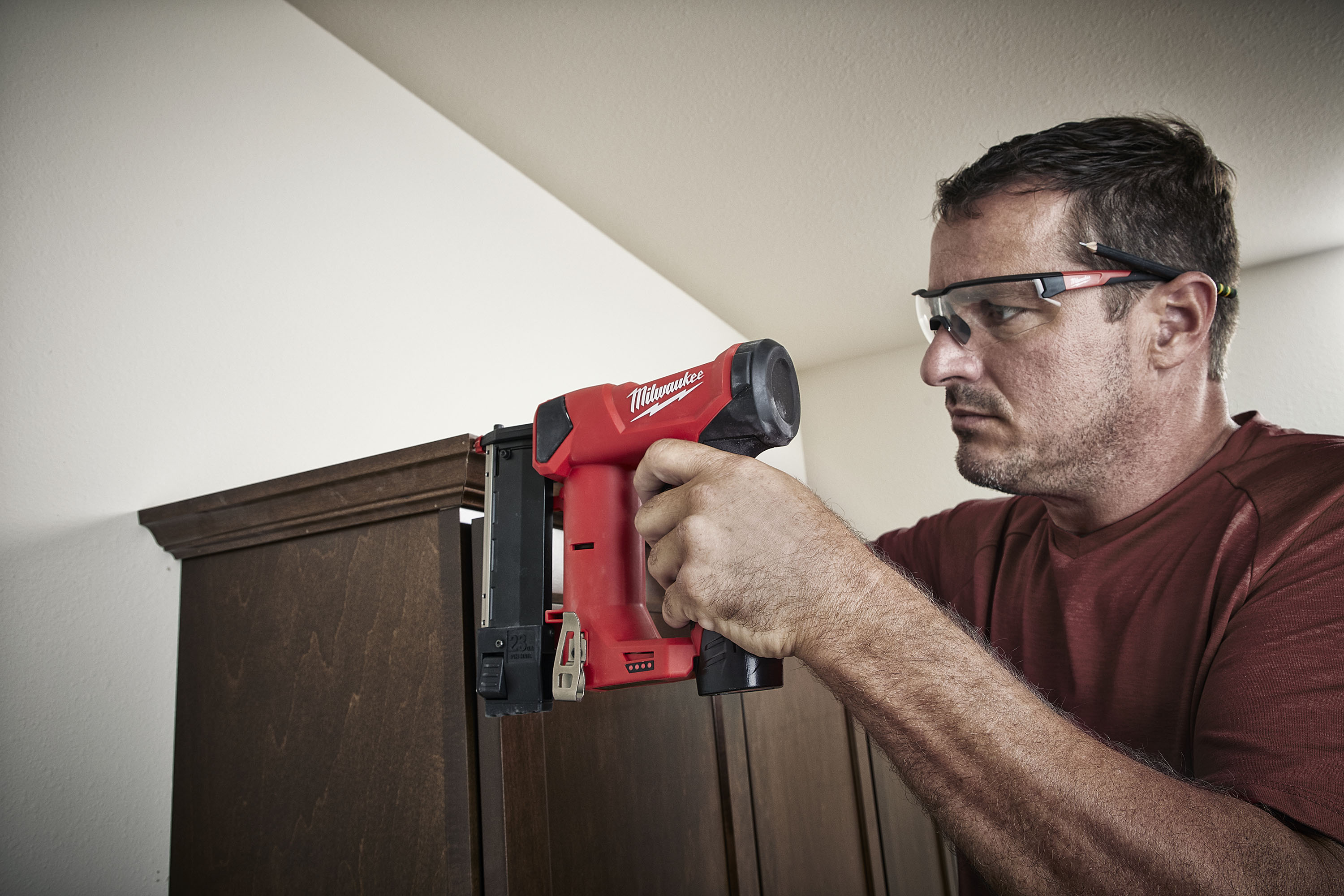If you have been looking for a 23-gauge nail gun, the Milwaukee M12 23-Gauge Pin Nailer might have already been on your radar. However if this type of nail gun is new to you don't feel out of the loop if you have not come across this model – or its competitors – before.
The 23-gauge pin nailer is likely the one nail gun DIYers are unfamiliar with, especially compared to the popularity of 18-gauge tools. But professional carpenters and woodworkers have been using pneumatic 23-gauge nailers for years. Called a pin nailer, this class of tools – which can either rely on a compressor a rechargeable battery – fires a thin wire that has no head, or a very slight one. That means the hole they leave behind virtually disappears so you won’t have to fill, sand, and finish the wood, which is ideal for pre-finished parts. When it comes to finished material, like the moldings that accompany kitchen cabinets or pre-finished hardwood flooring, that speeds up installation.
Like all nail guns, the size and shape of the fastener dictate the jobs it's best suited for. Big, fat 15-gauge nail guns are bigger than a dinner plate and will hold up heavy, pre-hung doors whereas a 23-gauge nailer is about 8x7-inches, 3 pounds, and fires fasteners that excel at holding thin pieces of molding. Unlike 18-gauge and 16-gauge nail guns, where there is a lot of overlap in the tasks they each perform, using a bigger nail when the project calls for a 23-gauge pin can make more work if you split the wood or have to go back and touch it up with filler.
Now you know what kind of jobs the Milwaukee M12 23-Gauge Pin Nailer is best suited to, find out how it performed in our testing. Then for more recommendations, see our best power tools.

Milwaukee M12 23-Gauge Pin Nailer specifications:
- Gauge: 23
- Nail length: 1/2–1 3/8 inches long
- Run time: drives about 750 nails per charge
- Power: cordless (12-volt, 1.5Ah battery)
- Weight: 3.3lbs with battery
Who does the Milwaukee M12 23-Gauge Pin Nailer suit?
This tool’s more specialized than other nailers. While it would never be the only nail gun you’d own, it might be a very handy complement if your projects align with what the tool’s best designed to do. If you’re installing cabinets, which come with plenty of pre-finished trim like toe kicks, filler pieces, and crown molding, this nailer will leave holes that disappear and won’t require touchups. If your window and door moldings include very delicate half rounds, thin bands of lattice, or mitered corners and returns, a pin nailer offers the right amount of holding power in conjunction with glue's strength.
If your projects required finishing after, with paint or stain, those holes disappear without any extra attention.
In the garage or workshop if you dabble in woodworking a pin nailer like the Milwaukee can act as a third hand. Woodworkers often reach for pin nailers to hold a delicate or very long joint together after applying glue. The nail acts as a clamp that stays in place, providing the necessary pressure to bond two pieces of wood. And because they disappear into the wood, they don’t require any filling after.
Get small space home decor ideas, celeb inspiration, DIY tips and more, straight to your inbox!

Choosing A 23-Gauge nail gun
A 23-gauge nailer isn’t a must-have for a DIYer, but if you work with pre-finished moldings, cabinets, flooring trim, small pieces of molding, mitered corners and returns, it can be a real time-saver. It leaves tiny holes that usually don't require touchups and keep things steady while the glue dries.
Traditionally, professional carpenters and woodworkers had to rely on a compressor to drive 23-gauge pin nails. But over the last few years, the cordless battery revolution has reached pin guns too, severing the compressor cord. That increases the maneuverability of the tool greatly and cuts down on maintenance, both of the tool itself and the compressor. Milwaukee has embraced this fully embraced the cordless revolution and we highly rate their Milwaukee M18 Fuel Cordless 16-gauge Nailer, too.
Pneumatic and battery-powered 23-gauge nailers are roughly the same size, though when you add an air hose to pneumatics, that makes them more cumbersome to use. Unlike other nailer categories, there aren’t too many buying decisions when it comes to cordless 23-gauge nailers. They all have straight magazines and all fire the same kind of nails, though some opt for an 18-volt battery versus the lighter weight, less powerful 12 volts of the Milwaukee.
Generally, cordless 23-gauge nailers sink fasteners from 3/8 to 1 3/8-inches long. 23-gauge nails, when you look at them in a box, are essentially a row of wire strips bonded together. The end that drives into the wood has a slight chisel on it, and the other end might be bare or have a slight head on it. Because the head is so slight, manufacturers of the nails print an arrow on the bonded strips of fasteners indicating how to properly load them into the tool's magazine. A 23-gauge pin is roughly 1/4 of the size of an 18-gauge tool.
What Is The Milwaukee 23-Gauge Pin Nailer like to use?
In hand, the tool feels lightweight and very manageable. The first thing you’ll notice is the dual triggers, which act as a safety system. Traditionally, all nail guns –pneumatic, fuel cell-powered, and battery-powered – relied on a contact tip to prevent accidents. To fire a nail, the head of the tool would have to be depressed against the work, then you can pull the trigger.
These tools use that method of pressing the work down because the pieces of wood you’d be working with are generally larger. But with a 23-gauge nailer, the wood is often smaller and pressing down on it might move it out of alignment, which is why Milwaukee opted for a two-trigger system. Pull one trigger, which acts as the safety, and then, while holding it down, pull the second trigger to drive the nail. After a dozen nails, it becomes second nature.
The Milwaukee is as fast as you'd need it to be. It drives nails using a canister of nitrogen built into the tool. Once that nitrogen is compressed, energy builds that then drives the nail forward. There is virtually no lag time between pulling the trigger and the nail firing out. And the trigger system means you can hold the safety trigger down (for up to about 40 seconds) and keep pressing the firing trigger to set nails in rapid succession. If you were adding a length of molding across a wall of wainscotting, that feature can help speed things up.
The tool’s nose is very narrow which gives it a great line of sight. There isn’t much guessing as to where the nail will land. The depth of drive adjustment is easy to use at the front of the tool, which helps when you’re assembling projects that have pieces of wood of vary in thicknesses. That ease of adjustment isn’t something you find on pneumatic nailers, which often require an Allen wrench to adjust. And the LED light helps brighten the work area too,
While it’s designed for thin wood, that doesn't mean exclusively softwoods. At 12 volts it has the power to sink fasteners into dense hardwoods like oak, maple, and mahogany.

Additional features of the Milwaukee M12 23-Gauge Pin Nailer
A clever detail Milwaukee’s engineers added to the nailer is a magnet at the top of the magazine. It's big enough to hold a handful of nails that would otherwise slide right out of the tool when you reload or swap out fastener lengths. That helps cut down on frustration. There is a half tip that comes with the tool that reduces the bulk of the tool’s nose to increase visibility even more. It’s a nice option to have.
There is a window cut into the magazine to show you the last 10 or so nails so you can, at a glance, see when it’s time to reload. In conjunction with that feature is a dry fire lockout, which prevents the tool’s piston from pushing forward if there is no nail in the magazine. That stops you from unnecessarily punching holes in the work. Fitted with a standard 12-volt battery, the Milwaukee stands up so you don’t need to rest it on its side each time you set it down. There is also a reversible belt clip so you can set depending on your preference to hang it from your left or right side.
Is The Milwaukee 23 Gauge Pin Nailer worth the money?
Yes, the tool is well designed and rugged. Battery-powered pin nailers tend to cost more than their pneumatic counterparts. But the better question is do you need a pin nailer? Most professional carpenters and woodworkers would likely trade in a compressor and air hose, and the setup and maintenance associated with them, for a cordless tool if the performance of the two versions is similar.
If you’re not working with a lot of pre-finished materials or building projects in the garage or workshop, you might not see the value of this tool. If you’re already using Milwaukee M12 tools, the case to buy this one is easier since it’s sold as a 'bare tool' which is often under $200.
About this review and our reviewer
Sal Vaglica has been covering all aspects of home improvement for over 10 years, for publications like The Wall Street Journal, This Old House, and Men's Journal.
He tested the Milwaukee 23-gauge pin nailer by firing nails into a variety of materials, like 1/2-inch-thick pine and oak, and 1-inch thick maple to test for accuracy, reliability, and ease of use.
Sal Vaglica has been covering all aspects of home improvement for over 10 years, for publications like The Wall Street Journal, This Old House, and Men's Journal.

